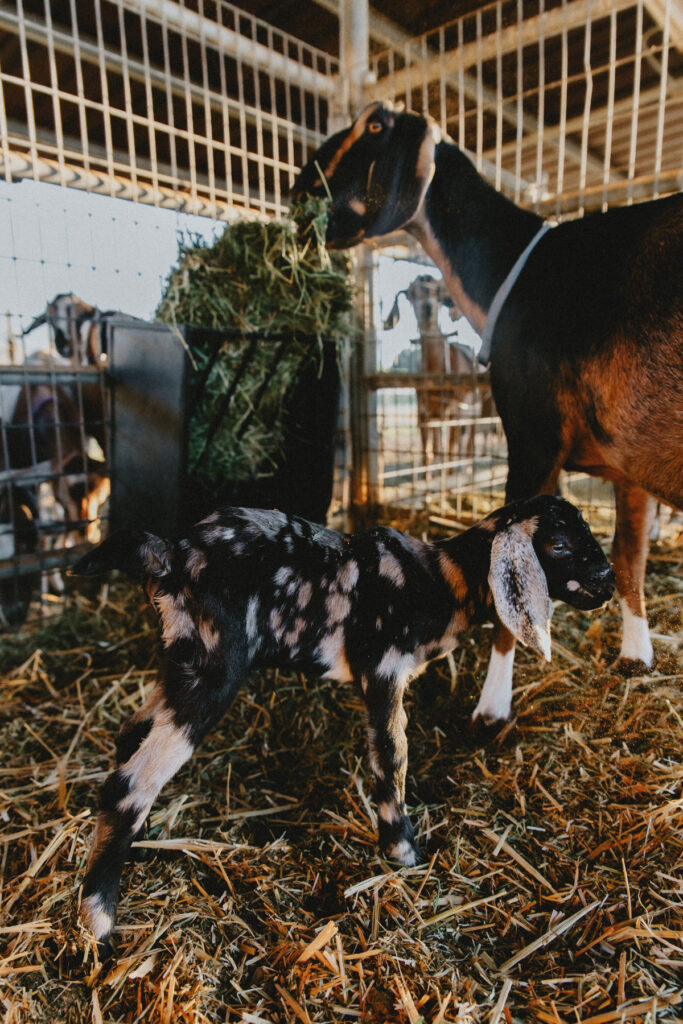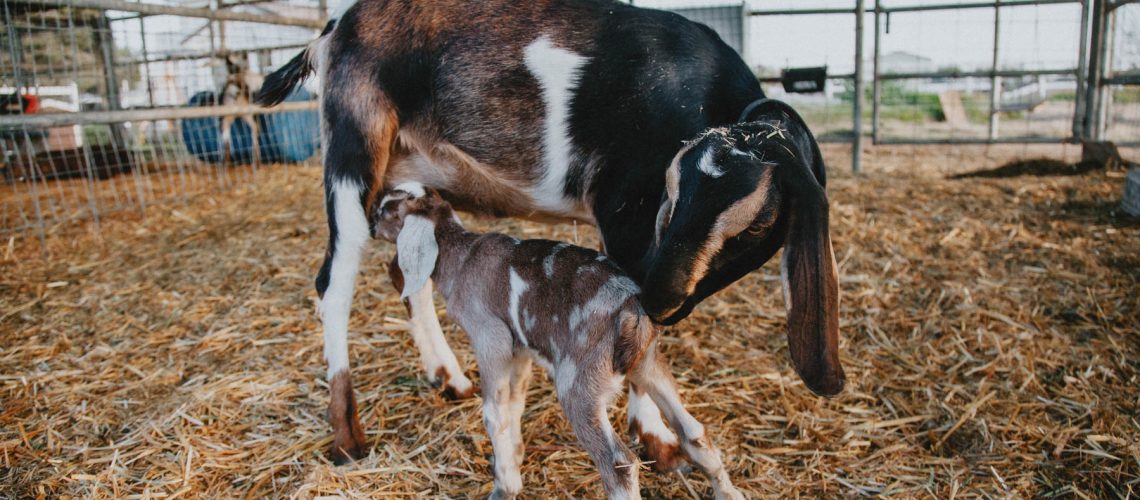If you’re preparing for kidding season on your homestead, you might be wondering what signs of goat labor look like, or what the stages of labor are. After years of raising goats on our Arizona homestead and assisting with many births, I’m here to walk you through what to expect—plus share my tried-and-true goat kidding supplies list and a free downloadable checklist to help you feel ready and confident.
👇 Grab your free printable Goat Kidding Checklist to keep in the barn! It includes all my essentials for kidding season.
Signs That Kidding is Near
A goat’s gestation is around 140-145 days, depending on the breed of goat you keep. This handy due date calculator for dairy goats is a must-have to help keep track of due dates for your girls!
Like humans though, a due date is really just a guess. Goats can kid a little before or (more commonly) after their date, so I start to keep a close eye on them in the couple weeks leading up to their due dates.
In the final days before labor, your pregnant doe will start showing clear signs that birth is coming. Her udder will suddenly “pop”—a noticeable overnight change where her udder fills and the teats look shiny and tight. Her vulva will swell, and if you’ve been monitoring her tail ligaments, you’ll notice they become soft and squishy. Just before labor, those ligaments will seem to disappear entirely, making room for delivery.
These physical signs are your best cues that your goat is preparing to give birth. Every doe is different, but once you get familiar with each goat in your herd, you’ll start to recognize their pre-labor quirks and behaviors.
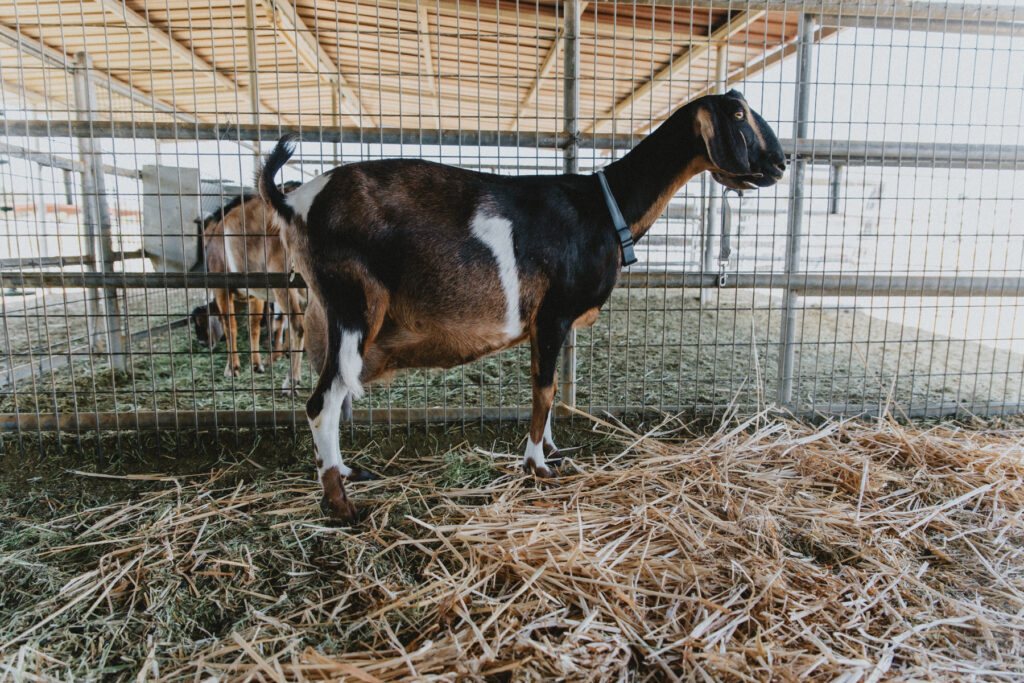
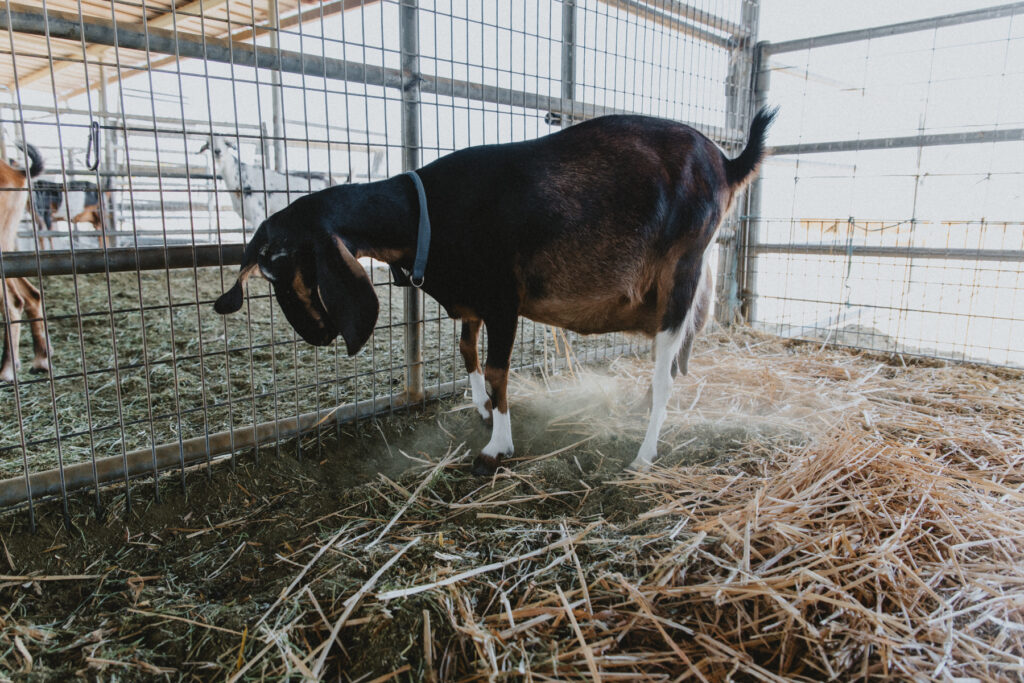
I have one goat in particular that loves to keep me guessing ’til the last minute, and surprise me with babies between my frequent barn checks! But most of my does give pretty clear signs of labor. While it is always best to be prepared in case something goes wrong, rest assured that most goat labors progress normally and without issues.
When to Move A Goat to Her Kidding Stall
If you have the barn space, it can be helpful to move your doe into a private kidding stall during early labor. But if you don’t, don’t worry—I’ve had plenty of does kid right in the communal area without issues. On one memorable occasion, my doe Rosie gave birth underneath the hay feeder during the morning breakfast rush!
Just be prepared to move her (and the kids) into a quieter space once the birth is over, especially so she can rest, bond, and enjoy her after-labor treat without the rest of the herd trying to steal it!
A simple kidding stall can be made by tying a cattle panel into a U-shape against a wall—nothing fancy required. Just a safe, clean space where your goat has room to move around, and where you can assist if needed.
The 3 Signs and Stages of Goat Labor
Understanding the signs and stages of goat labor helps you know what’s normal and when to offer help. Here’s what to expect:
1. Early Labor
This is when your doe starts to act “off.” She may separate herself from the herd, stare into the distance, paw the ground, or talk softly with gentle bleats. These are signs that her body is preparing: hormones are shifting, contractions are starting, and the kids are getting into position.
Look for:
Swollen, soft vulva
Loss of tail ligaments
Staring off into space and “zoning out”
Pawing, nesting, or pacing
Clear or white discharge from her vulva
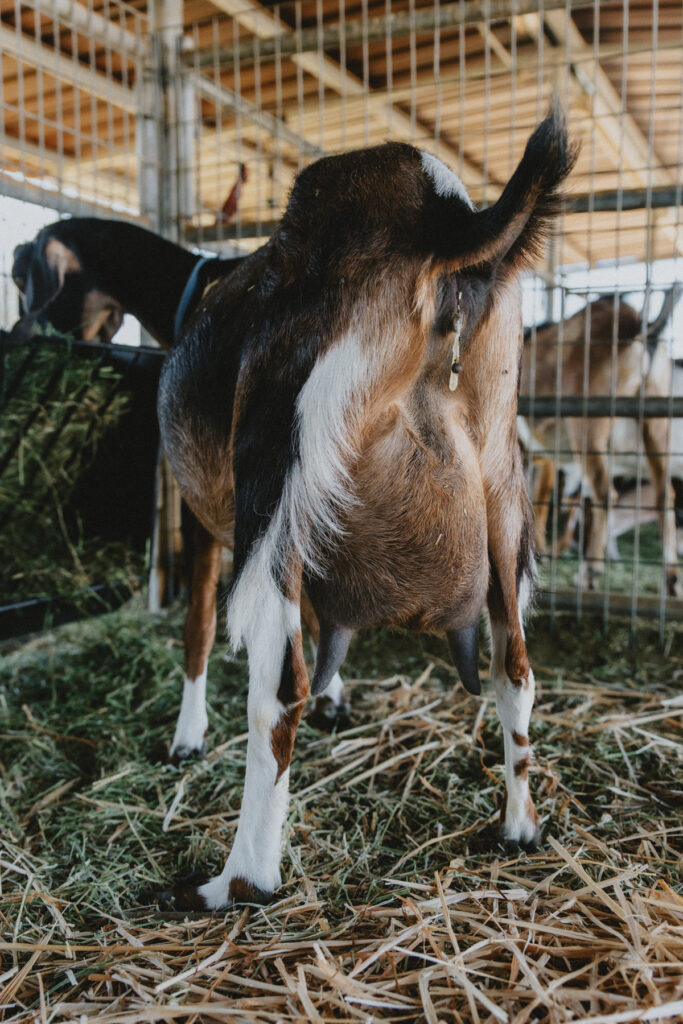

2. Active Labor and Delivery
Once your goat starts pushing, things tend to progress quickly. She’ll grunt or cry out, and you’ll see the amniotic sac (“bubble”) appear. Ideally, you’ll see two front hooves and a nose—the perfect diving position.
Don’t panic if the tongue is sticking out—this is normal!
You can assist by gently pulling downward on the hooves during contractions if your goat is struggling a little to get the kid out. I tend to sit back and not intervene, but I do get sympathetic for my girls if it’s taking time to get a big baby out!
While the diving position is ideal, some kids will present back feet first, rump first, or in other positions that can sometimes require help. We call this dystocia when a kid is presenting in a non-optimal position and needs maneuvering to be born.
For a thorough description and diagrams of possible kidding presentations and how to assist your goat in delivering with each one, I highly recommend keeping a copy of Holistic Goat Care by Gianaclis Caldwell at hand.
Once the baby is out, wipe any mucus from its nose and mouth, and bring it right over to mama so she can start licking and bonding.
If you have a goat that is a first-timer, or a little hesitant to approach their newborn kid, try wiping some of the amniotic fluid (goop) from the baby onto mama’s nose. Often that will help kickstart that hormonal urge to nurture her baby.
👉 Be sure to watch the goat birth video included below to see what a normal delivery looks like in real-time!
Most goats deliver multiples, so once the first kid is born, another will likely follow within 30 minutes, and often much sooner. Keep an eye out for additional bubbles and signs of pushing. A sign that no more kids are coming is when you see the membranes of the placenta, which often look like a long stringy sack full of blood and fluid.
3. Delivery of the Placenta
The final stage of labor is the delivery of the placenta, which may take a few hours. Goats usually have only one placenta, even with multiple kids. Some does eat it, which is natural, but if she doesn’t, you can remove it. Some breeders opt to stick around until it is delivered, and remove it immediately to reduce the risk of choking on the stringy afterbirth.
I take a laid-back approach here. As long as my doe is eating, drinking, and bonding well with her kids, I let nature do its thing and just check back in later.
Often after the last kid has been born, a blood-filled bubble (amnion) will hang from the goat’s rear end. Don’t attempt to pull on this or remove it. The weight of the fluid-filled membranes will help ensure the entire placenta is birthed in once piece. Your doe may continue to paw the ground or grunt occasionally as she waits to birth the placenta.
Placental membranes hanging from her vulva for longer than 24 hours are a sign some bits may be retained. If your goat develops a fever, has putrid smelling discharge or won’t eat or drink, call a vet right away.
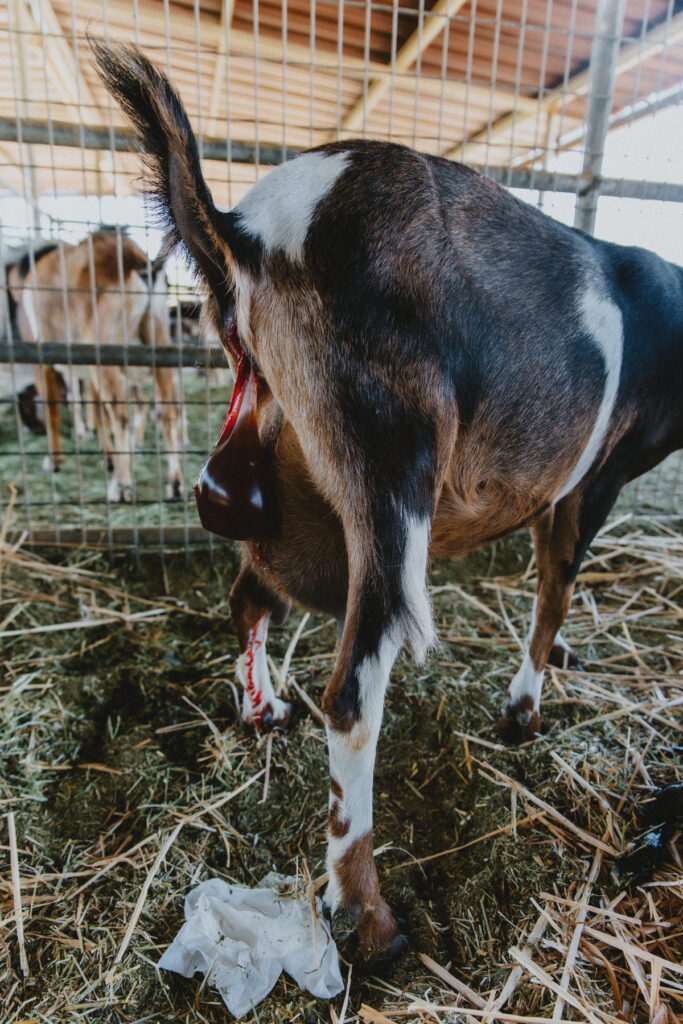
Caring for Does and Kids Postpartum
Once all kids are born, I shift my focus to aftercare:
-
Offer warm molasses electrolyte water to help mama recover
-
Provide fresh alfalfa hay + grain for energy and milk production
-
Make sure each kid nurses within the first hour to get that crucial colostrum
-
Help dry and warm kids with towels or a blowdryer on cold days
-
Check that all kids are getting enough to eat, especially with multiples
- Dip umbilical cords in 7% iodine up to the naval (or use goldenseal on the cords, like we do on our homestead)
Healthy, vigorous kids will try to stand and nurse within 30–60 minutes of birth. If they’re sluggish, a little molasses on the gums can help give them a boost. I like to help get the kids latched before leaving the barn to make sure they get a full belly of colostrum. Lately, my girls (11 + 9 years old) have decided this is their special kidding job. It’s so fun to watch them take charge of this important part of baby goat care.
Does should have an appetite and be attentive to their kids. You can expect your doe to continue to bleed and expel discharge for up to two weeks after kidding. This blood (lochia) should be light red to dark brown, and will taper off as she heals.
Final Thoughts
Kidding season is my favorite time on the homestead. New life arriving in all its messy glory is just the best.
Kidding be overwhelming the first time or two. Even after several years I still get the butterflies and worry about my does sometimes! But with time and practice, knowing what’s normal and when to step in and intervene will become second nature.
New life truly is a miracle every time. The best gift you can give yourself is confidence. Keep this goat kidding supplies list handy, observe the signs, and trust your instincts.
And don’t forget to watch this goat birth video to see it all in action.
👉 Download the Free Goat Kidding Checklist
👉 Check out my simple recipe for Homemade Electrolyte Water for Goats After Kidding
🎥 Watch a Textbook Goat Birth Video Here
🎥 Watch a video of a kidding that required some intervention
I’ll be over here on my own homestead, snuggling baby goats and breathing in their sweet scent, rooting for you all the way.
